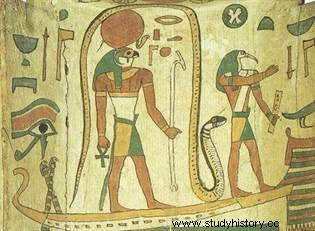 Egyptian Mythology occupied a central place in the history of ancient Egypt, the Egyptian gods exerting a strong influence on society and daily life in the land of the pharaohs. Very sophisticated, the Egyptian pantheon is one of the mythologies including the most deities. For over 3,000 years, the Egyptians strove to honor them, erecting temples and making offerings at the feet of the statues. These are part of their daily lives and can interfere with natural events. Atum also known as Ra is the very first god, the sun god who created the world and humans...
Egyptian Mythology occupied a central place in the history of ancient Egypt, the Egyptian gods exerting a strong influence on society and daily life in the land of the pharaohs. Very sophisticated, the Egyptian pantheon is one of the mythologies including the most deities. For over 3,000 years, the Egyptians strove to honor them, erecting temples and making offerings at the feet of the statues. These are part of their daily lives and can interfere with natural events. Atum also known as Ra is the very first god, the sun god who created the world and humans...
Egyptian mythology and origin of the world
Originally there was the Noun , liquid chaos:the flooding of the Nile mixed with mud. There was neither sun nor air. There are several versions relating the creation of the world. The Priests of Hermopolis believe that it is the fruit of eight deities:the ogdoad, grouped into four pairs of gods:male and female. The latter, which symbolize water, infinity, darkness and what is hidden, caused the Nile to recede so that the sun could emerge from a lotus bud.
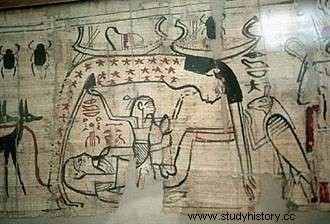 From the Heliopolitan point of view , life was born in Heliopolis, the city of the sun thanks to the Ennead:the group of nine gods. The Sun God Atum (evening sun) which is also called Rê (zenith sun) or Khepri (morning sun), emerges from Noun, creates a man's body and dries up the mud to create the earth. He will then give birth to the first pair of gods:Shou , the god of air and Tefnut , the goddess of humidity. They discover the world. Believing to have lost them, Atum sheds tears which engender the birth of men. In turn, Shu and Tefnut, create two other gods:Geb , the god of the earth and Nut, the sky goddess. This couple subsequently begets four other gods:Osiris , underground god wearing the white crown, Isis his wife, Seth :god of Chaos and Nephthys his wife.
From the Heliopolitan point of view , life was born in Heliopolis, the city of the sun thanks to the Ennead:the group of nine gods. The Sun God Atum (evening sun) which is also called Rê (zenith sun) or Khepri (morning sun), emerges from Noun, creates a man's body and dries up the mud to create the earth. He will then give birth to the first pair of gods:Shou , the god of air and Tefnut , the goddess of humidity. They discover the world. Believing to have lost them, Atum sheds tears which engender the birth of men. In turn, Shu and Tefnut, create two other gods:Geb , the god of the earth and Nut, the sky goddess. This couple subsequently begets four other gods:Osiris , underground god wearing the white crown, Isis his wife, Seth :god of Chaos and Nephthys his wife.
As for the Memphite priests , they envision the creation of the world with the god Ptah , gods of metalworkers, craftsmen and architects. He would have preceded Atum and would have created the world by his “thought and his creative word”. Memphis, another great spiritual center of Egypt, is the rival city of Heliopolis. Ptah can take on several appearances, that of the Bull Apis or that of Osiris.
Humanity against the Egyptian gods
At the beginning of the world, Atum unites the gods revolted against him, to punish humanity deemed ungrateful. Through the lion-headed goddess Sekhmet, he sent his flame-breathing eye on humanity without wanting to eradicate it. Sekhmet is part of the Memphite triad with Ptath of which she is the wife and their child Nefertum . She is a warrior goddess and protector of the creator. Sekhmet has an insatiable appetite, intoxicated by the smell of blood, she could not stop the carnage ordered by Atum. In order to protect humanity, the gods used trickery by making fake blood:a mixture of red ocher and beer. The drunkenness of the goddess saved the humans.
Annoyed at having been trapped, Sekhmet went into exile in the depths of Nubia. Deprived of his formidable ally (his divine eye), Atum decided to send Thoth, the god of wisdom, to find her and bring her back. Taking on the aspect of an ape, he used flattery to persuade the goddess to return. Once back and appeased, Sekhmet is said to have taken the form of the goddess Bastet cat-headed, goddess of the home and protector of births.
The Jealousy of Seth and the Ousting of Osiris
Before being an underground god, the god Osiris reigned over the throne of Egypt in order to bring civilization and instruct humans on how to fish, cultivate the land or even play music. He is the husband of his sister Isis. As for Seth, his younger brother, he is responsible for reigning over the arid deserts populated by animals.
Seth is one of the oldest and most hated gods of Egypt. He is the god of storms and thunderstorms. It is depicted as an unidentified animal with a long snout and long straight ears. Symbol of evil, it can manifest itself in animals with red coats. It is nevertheless necessary for the balance of the universe by embodying the harmful powers.
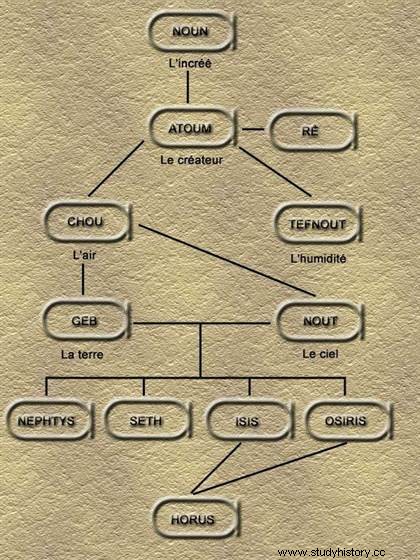 Jealous of his brother and eager to steal the throne from him, Seth implemented a strategy to get rid of Osiris. He invited his brother to a banquet and had a large chest brought which he intended to offer to whoever could lie down completely in it. The guests tried in vain, Osiris lent himself to the game and fit perfectly into the trunk. Seth, locked him in it and threw the coffin into the Nile.
Jealous of his brother and eager to steal the throne from him, Seth implemented a strategy to get rid of Osiris. He invited his brother to a banquet and had a large chest brought which he intended to offer to whoever could lie down completely in it. The guests tried in vain, Osiris lent himself to the game and fit perfectly into the trunk. Seth, locked him in it and threw the coffin into the Nile.
When she learned of her husband's terrible misadventure, Osiris' wife decided to go in search of the coffin. Isis, located him in the Nile and then hid him in the swamps of the Delta. Unfortunately, Seth found the coffin and furious, he cut the body into 14 pieces which he scattered across the land. Isis was not discouraged and resumed her investigation.
Gradually, she was able to gather all the members, except one:the sex of the god who was eaten by the oxyrhynchus fish. You should know that Isis is revered for her cunning and her intelligence. With the help of Anubis , god of the dead represented as a man with the head of a jackal, she tried to revive the body of Osiris. The latter, who ends up emerging from his sleep, will now reign over the kingdom of the Dead.
Angry Son:Horus' Revenge
Thanks to her powers, Isis restored to Osiris his missing limb and was able to conceive a new child with him:Horus . This one will be raised in secret by his mother in the reeds of the marsh of Chemnis to be protected from his uncle. He is the falcon god carrying the solar disc, his name means the one "who is above" because he is the embodiment of the sky and the sun.
As an adult, Horus claimed the inheritance of the throne of Egypt and summoned the tribunal of the gods chaired by Ra. This struggle lasted 80 years. At first, the trial does not lead to any agreement because Ré sees in Seth a counterweight against his enemy Apophis. Horus challenged his uncle to a fight of a rare violence where he lost an eye and emasculated Seth. Having pity on her brother, Isis asked her son not to kill Seth. Mad with anger, he ends up cutting off his mother's head. Thoth, intervened to separate the two rivals and reconstructed a head for Isis:a cow's head and the eye of Horus called:the'oudjat .
He donated his eye to his father who was able to regain his sight. Horus won his case in court thanks to the intervention of Osiris and recovered the throne of Egypt. He will be the first of the pharaohs.
The Eternal Enemy of Creation:Apophis
Apophis is the god of the night, recognizable by his appearance of a huge serpent , he personifies evil. He would be the son of Neith, the goddess of war and hunting. According to legend, every morning before sunrise, he fights fiercely against Ra to prevent day from appearing. He wishes to plunge the world into the original chaos.
The fight always ends in failure for Apophis thanks to the defenders of the Barque of the Sun God sailing on the Nile:Seth and his harpoon, the goddess Bastet and the disorienting powers of Isis. In the event of an Eclipse, it is said that the serpent god succeeded in swallowing the barque of Ra. However, Apophis cannot truly die because he is part of the universe.
The life of the Egyptian gods
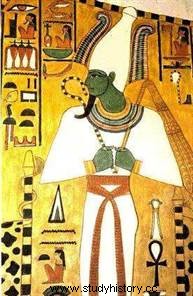
Like humans, gods can eat, drink, talk, wear clothes and even have feelings:anger, joy, sadness… They are dressed in the same white linen suit and hold the Was scepter , emblem of power and on the other hand the sign of life:ankh (handle cross). They remain in heaven but are present on earth thanks to their ba . It is a spirit. The Ka is the vital energy that is nourished by the offerings. The ba resides in the statue located in the sanctuary but can also find refuge in a sacred animal which differs according to the god.
There are several categories of gods:
- - Cosmic deities such as air and sky or geographic deities representing rivers, mountains
- - Zoomorphic deities, bull-headed males, Aries, falcons and women:vulture, cobra, lioness, cow...
- - Hybrid deities:the best known remains the sphinx
These categories include "national" gods adopted by all of Egypt but also local gods like Neith in Sais, Amon in Thebes, Knum in Elephantine... At the origin each region of Egypt venerated its own god, some of them were exported more than others. Osiris, local god, will be worshiped throughout the country which contains between 38 to 42 constituencies. As well as Maât, goddess of the balance of the world and wearing an ostrich feather crown.
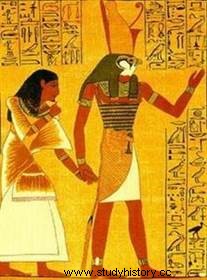 In order to maintain the stability of the world, the Egyptians believed that they had to honor their gods through offerings and feasts rituals. Unlike the Greek gods, the Egyptian gods are less accessible and don't mix as easily with humans. Interactions take place in temples. The statues in their effigy were treated with the greatest care because the Egyptians believed that they contained the very spirit of the god . They received food and wine or water.
In order to maintain the stability of the world, the Egyptians believed that they had to honor their gods through offerings and feasts rituals. Unlike the Greek gods, the Egyptian gods are less accessible and don't mix as easily with humans. Interactions take place in temples. The statues in their effigy were treated with the greatest care because the Egyptians believed that they contained the very spirit of the god . They received food and wine or water.
The Decline of the Egyptian Gods
Despite their popular immortality, some Egyptian texts evoke the possible mortality of the gods. This is the case of the "Book of the Dead" in verse 154 explaining that death awaits "every god and goddess ". The work describes the end of the world through a dialogue between Atum and Osiris who fears finding himself in darkness. The gods would perish with the end of the cosmos itself, only the water of chaos would remain.
The loss of the pagan religion is linked to the advent of Christianity and Islam. From 383, Emperor Theodore closed many pagan temples across the Roman Empire. Egyptian temples are either abandoned or destroyed.
The main Egyptian gods
| Name | Parentage | Function | Representation |
|
Amun | Associated in triad with the goddess Mut and the son god Khonsu | Sun god and creator in Thebes under the name of Amun-Re and dynastic god of Egypt from the Middle Kingdom | man wearing a crown with two tall feathers |
|
Anubis | Illegitimate son of Osiris and Nephthys | Deity in charge of embalming practices; in the afterlife, god acting as intermediary between the deceased and the funeral court; official guardian of the necropolises | jackal or jackal-headed man |
|
Apis | Son of a cow impregnated by Ptah | Sacred bull representing Ptah on earth, also associated with Osiris and Re | bull wearing the sun disk Sacred bulls buried in the Serapeum of Memphis |
|
Apophis | Cosmic enemy symbolizing evil and all destructive forces. | gigantic sized snake | |
|
Aton | Sun god and creator at the time of Amenhotep IV | sun disk with rays ending in hands holding crosses of life | |
|
Atum | Creator god in Heliopolis, embodying the setting sun | Male (without particular attributes) | |
|
Bastet | Daughter of the Sun and Eye of the Star | Goddess embodying the peaceful aspects of dangerous goddesses such as Sekhmet | cat or cat-headed woman |
| Bees | Familiar god, protector of the home, pregnant women and children | bearded dwarf, with crooked legs and happy features, represented from the front | |
| Geb | Son of Shou, the vital breath, and of Tefnut, heat. brother and husband of Nut, goddess of the sky. father of Osiris, Horus, Isis, Nephthys and Seth. | God personifying the earth. | man lying on the ground |
| Happy | Personification of the Nile, symbolizing flooding, fertility and abundance | androgenic genius with a bloated belly and a hanging chest | |
|
Hathor | Daughter of Re considered as the eye of the solar star. Wife of Horus. | Goddess of multiple functions, celestial divinity, goddess of distant lands, of joy, of the sycamore... | woman wearing two horns enclosing the solar disc, cow, or woman with a cow's head |
|
Horakhty | God creator in Heliopolis incarnating, under the name of Rê-Horakhty, the sun at its zenith | falcon-headed man, or falcon, headdress of a sun disk | |
|
Horus | Son of Osiris and Isis. Husband of Hathor (sometimes son of Hathor) | Divinity with multiple functions:celestial and solar god, direct protector of Egyptian royalty, representative of the gods on earth... | falcon or falcon-headed man |
|
Isis | Daughter of Geb, the earth, and Nut, the sky Wife and sister of Osiris | Universal goddess with multiple functions who acts in all areas, both in the world of the living and in the afterlife | woman wearing high back chair |
|
Khnum | Associated with Neith (Esna) and Satis and Anoukis (Elephantine) | Creator God (Esna); patron of the cataract and guardian of the sources of the Nile (Elephantine) | ram or ram-headed man |
| Maat | Daughter of Re | Goddess of Justice and Truth | woman wearing an ostrich feather or ostrich feather alone on her head |
|
Montu | Associated in triad with the goddess Rattaouy (the female sun) and the child goddess Lounyt | Warrior god of the Theban region | falcon-headed man wearing the tall two-feathered crown |
|
Mout | Associated in triad with the god Amun and the son god Khonsu | Goddess worshiped as consort of Amun | woman carrying the remains of a vulture on her head |
|
Nephthys | Daughter of Geb, the earth, and Nut, the sky. Sister of Isis, Osiris, Horus the Elder and Seth; wife of Seth | Protector of the deceased alongside her sister Isis | woman wearing the two hieroglyphic signs used to write her name |
|
Nout | Daughter of Shou, the vital breath, and of Tefnut, the warmth Sister and wife of Geb. Mother of Osiris, Horus the Elder, Isis, Seth and Nephthys Goddess personifying the sky | woman forming, with her starry body, the celestial vault or immense celestial cow | |
|
Osiris | Son of Geb, the earth, and of Nut, the sky. Husband and brother of Isis | God of the dead and master of the afterlife | mummified man, wearing the atef crown, holding the butt and the whip crossed on the chest |
|
Ptah | Associated with the goddess Sekhmet and the child god Nefertum | Creator God of Memphis, Patron of Craftsmen and Protector of the Memphis Necropolis | man enclosed in a mummified sheath and wearing a blue cap |
|
Re | Creator god in Heliopolis, embodying the sun at its zenith | Combined with many divinities:Re-Atoum, /\mon-Re, Re-Horakhty, Sobek-Rê, Khnum-Rê... | man, sometimes with the head of a falcon, wearing the sun disk |
|
Sekhmet | Associated with the god Ptah and the son god Nefertum | Goddess embodying the solar eye and the dangerous forces, having the function of annihilating the enemies of the sun | woman with a lion's head |
|
Seth | Son of Geb, the earth, and Nut, the sky Brother of Osiris, Isis, Horus (Elder and Nephthys Uncle of Horus | Divinity with two facets:god of evil and thunder, responsible for troubles and disorder but also protector god of the solar boat | mythical animal or man with the head of this same animal |
|
Shou | Son of Re-Atum-Khepri. the sun Brother and husband of Tefnut. the heat Father of Geb, the earth, and of Nut. the sky | God of the air symbolizing the vital breath | man sometimes wearing a feather |
|
Sobek | Son of the goddess Neith (Sais); associated in triad with the goddess Hathor and the son god Khonsu (Kom-Ombo) | Lord of the Waters; creator god under the name of Sobek-Rê | crocodile or crocodile-headed man |
|
Thot | Divinity with multiple functions:god of the moon, god of writing and science, messenger and clerk of the gods, master of knowledge, patron of scribes | man with ibis or baboon head |
Non-exhaustive bibliography
- Richard H. Wilkinson, Illustrated Dictionary of Ancient Egyptian Gods and Goddesses, Infollio, Singapore, 2006
- Nadine Guilhou, Egyptian Mythology, Marabout, Paris, 2006
- Guillemette Andreu, Egyptians in the time of the pharaohs, Pluriel, Evreux, 1997
